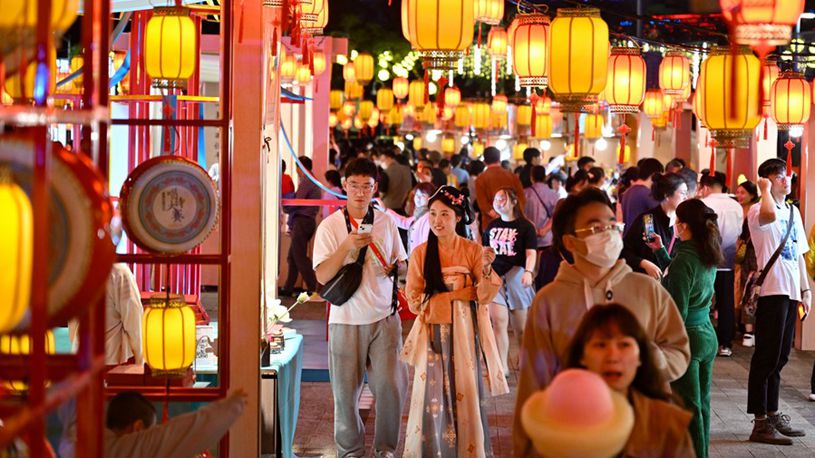People and lives above all else in China's COVID response
BEIJING, Feb. 23 (Xinhua) -- China has declared a major and decisive victory in its response to COVID-19 recently, as the country is steadily entering a new phase of COVID-19 prevention and control, which has been downgraded under the management of Class B infectious diseases.
Over the past three years, an unchanged philosophy guiding the decision-making in the country's response to COVID-19 is putting the people and their lives first.
SAVING LIVES AT ALL COSTS
In early 2020, the sudden onslaught of the previously unknown virus plunged the central hub city of Wuhan into chaos. More than 40,000 medical workers nationwide were mobilized to the rescue.
In a short period, 16 stadiums and conference and exhibition centers were revamped into makeshift hospitals. As a result, 94 percent of local COVID-19 patients recovered.
Since then, the COVID-related medical expenses incurred during concentrated hospitalization have been covered by the government. The research and development of vaccines, testing reagents, and medication gathered speed. All residents got the choice to get vaccinated for free.
As of January, more than 90 percent of the 1.4 billion population have been fully vaccinated.
China has also been improving its medical treatment capacity. By the end of 2022, the number of intensive care unit (ICU) beds in China had reached 216,000, and 135,000 hospital beds could be converted to intensive care.
Since November last year, China has been optimizing its response measures to focus on safeguarding people's health, preventing severe cases, and securing a smooth transition within a relatively short period. More than 200 million patients were treated, and nearly 800,000 patients in serious conditions received effective treatment in the transition phase.
The country's mortality rate for COVID-19 has been kept at the lowest level globally.
MINIMIZING IMPACT ON PEOPLE'S LIVELIHOOD
Living in central China's Changsha, a 77-year-old woman surnamed Li did not have to leave home amid the epidemic peak in December, as volunteers would deliver daily necessities such as eggs, meat, vegetable and medicine to her doorstep.
The country has endeavored to ensure people's livelihood in times of hardship.
China has pooled every possible effort to ensure sufficient medical supplies, especially in rural areas. For example, before the Spring Festival of 2023, authorities made sure the provision of two finger-clip oximeters for every village health clinic across the country free of charge.
During the regular epidemic prevention period, China poured resources into stabilizing employment and prices to minimize the epidemic's impact on people's lives. As a result, in 2022, China's consumer price index (CPI) rose by just 2 percent from the previous year, much lower than that of developed economies.
In the meantime, a total of 37.5 billion yuan (about 5.43 billion U.S. dollars) in price subsidies have been distributed to hundreds of millions of people in need during the pandemic.
ADJUSTING MEASURES IN TIME
The country has been monitoring the evolving situation concerning the epidemic and adjusted its COVID-19 response measures accordingly.
In recent months, China has made active adjustments in its COVID response, ranging from 20 measures in November and ten new ones in December. It also changed the Chinese term for COVID-19 from "novel coronavirus pneumonia" to "novel coronavirus infection." Since Jan. 8, China has been managing COVID-19 with measures designed to combat Class B infectious diseases instead of Class A ones.
In the meantime, the country has implemented policies to alleviate financial stress for COVID-19 patients and ensure their medical needs are addressed in time.
So far, there are more than 600 kinds of drugs for treating COVID-related symptoms in the catalog of medicines covered by the national medical insurance system.
A meeting of the Standing Committee of the Political Bureau of the Communist Party of China Central Committee held on Feb. 16 stressed the need to thoroughly review the experience and practices of the past three years, especially those implemented in the recent period. The meeting called for improving relevant mechanisms and measures, strengthening the COVID-19 prevention and control work in the new phase, building a stronger health service system, and firmly consolidating achievements.
Photos
Related Stories
- China steadily enters new phase of COVID response: spokesperson
- Science-based approaches create "major, decisive victory" in COVID fight
- New study finds disparities in U.S. pediatric medical, childcare disruption due to COVID-19
- New study shows COVID-19 vaccination linked to fewer cardiac events
- China achieves major, decisive victory in COVID response: CPC leadership
- U.S. starts trial to evaluate antiviral in adults hospitalized with COVID-19
Copyright © 2023 People's Daily Online. All Rights Reserved.









